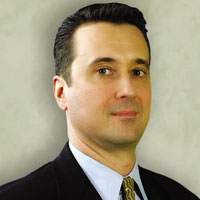
Last week, I took an afternoon off from work to do what we all dread: wait for the cable company. I’d been without Internet service for several days and couldn’t survive another weekend spent offline. I made some lunch and settled in at my desk to wait for the cable technician to arrive between noon and 5:00 p.m. The afternoon slipped slowly away with no tech, so I called the cable company at five to determine the Estimated Time of Arrival.
“He’s stuck in traffic,” the service operator said. “He’ll be there soon.”
“Soon” stretched to 6:00 p.m., then to 7:00 p.m.
I called again. Where is he, I demanded.
“Sir, I don’t know where he is. Would you like to reschedule?”
And on it goes. Whether it’s cable, washing machines, air-conditioning – any kind of service or repair, customers hate to wait. And, smart businesses are beginning to realize this fact. Furthermore, they are beginning to realize that customers hate waiting so much that they are willing to pay a little extra not to have to wait. As a result, for many forward-thinking B-to-B as well as B-to-C companies, instead of a drain on company time and resources, after-sales service/maintenance is becoming a viable revenue channel.
In fact, according to Boston-based Aberdeen Group, 78 percent of OEMs currently or soon will manage post-sales service as a strategic profit center -- a dramatic shift in traditionally product-centric companies which viewed service as a “necessary evil” and an unavoidable cost of doing business. Sears Holding Corp., for example, has already seen that service, when properly delivered, can lead to additional sales, either for products or additional services. “At Sears, the field technicians are customer advocates,” said Mark Vigoroso, Chief Research Officer and Senior Vice President at the Aberdeen Group. “They are adept at responding to customer needs, which increasingly translates into additional sales.”
Trends Converge
In the next twenty years, service will be the key differentiator between those businesses that succeed and those that don’t. And, technology is being utilized to “supercharge” service in a growing number of industries. Three important industry and cultural trends are converging to make this a reality.
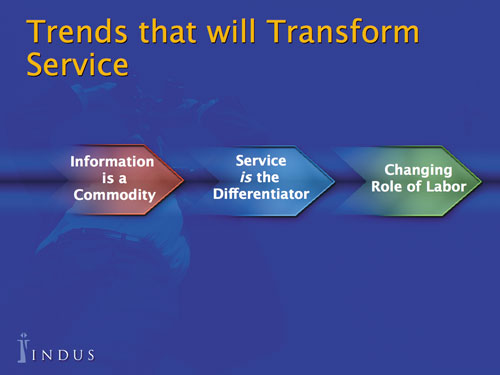
1. Aging Workforce
The aging workforce is a major driver in the advancement of knowledge management
technology, a key enabler of service optimization. More than 76 million baby boomers will be retiring soon, resulting in an imminent knowledge drain that will first hit oil and gas, utilities, government, education and manufacturing industries. Frank Lambert, electrical engineer and Program Manager at Georgia Institute of Technology’s National Electric Energy Testing Research and Application Center, noted this trend will hit utilities hard because of the amount of downsizing that occurred due to deregulation and the experience that was lost as a result. Among the utilities with whom the center works, Lambert agreed that a large number of experienced senior staffers are retiring, leaving a 10-to-15-year worker gap.
Furthermore, by 2010, the U.S. Department of Labor, Bureau of Labor Statistics reports that the number of unfilled skilled worker posts will reach about 5 million, ballooning to 14 million by 2015. According to the Utilities Business Education Coalition, more than 90 percent of CEOs surveyed face the difficulty of finding entry-level people to replace retirees.
And, according to Forrester Research Inc., one participant at a recent event said his organization found it requires two to 2.5 new employees to replace just one highly experienced worker – partly due to education but also because attitudes about work are quite different between boomers and generation X and Y.
Les Duncan, Vice President and Chief Information Officer for Atmos Energy Corp., believes technology is crucial to capturing that knowledge. Many of the field service workers have specific knowledge about reading meters, and in particular, where many of those meters are located. One may be in the middle of a forest or tucked away on a hill and only one worker in the company knows its exact location. As Vigoroso puts it, “If historical asset knowledge is not
captured in a system of record, it will disappear with the departure of the retiring worker.”
2. Technological Advancements
Technology, then, is the key to capturing that data which otherwise too easily disappears.
Yet even as it’s becoming more expensive to hire people to perform those jobs, the technology needed to capture that knowledge is actually getting less expensive to purchase and deploy.
Like the Y2K bug, the pressure to capture knowledge forces businesses to exploit existing technology. Michael Lamb, Executive Director of Utility Innovations for Xcel Energy, believes that technology can help “retain that knowledge and make sure that we’re more efficient so that we can get the same amount of work done with fewer people.”
Progressive companies are instituting more automation and streamlining business processes that will reduce the number of workers needed as well as the cost of doing business.
Those businesses are also implementing best-of-class service delivery management practices and software tools to drive efficiency improvements across their entire service supply chains. These advances in technology and technology deployment are the next trend to supercharge service. When the technology involved in condition-based monitoring and maintenance of a product aligns with the ability of a service provider to quickly access customer data, service parts information and service scheduling information - combined with the ability to seamlessly connect the back and front office to the field using a mobile device of choice - the result can be a level of convenience that wasn’t possible until now. Imagine copiers that automatically report to the service desk that they’re running out of toner or that the document feed belts will need to be replaced soon. Even better, the service tech, armed with invaluable customer data, initiates the process of selling a new copier or a service contract while he’s replacing the document feed belt. Hence, service migrates from a cost center to a strategic profit center.
Another example of technology supercharging service is occurring right now. A local restaurant in Atlanta offers its patrons a frequent diner card. Through radio frequency identification (RFID) tags embedded in the cards, diners are identified when they arrive in the parking lot and then ushered to the front of the line to a table.
Wait staff knows in advance the guest’s favorite cocktail, meal preferences and even whether the steak should be rare or medium well. Once again, this knowledge – previously stored only in the mind of the worker, if anywhere – can now be accessed from a centralized database that expands and changes as the data evolves. The value of the customer satisfaction, loyalty and convenience that this service will engender cannot be overstated.
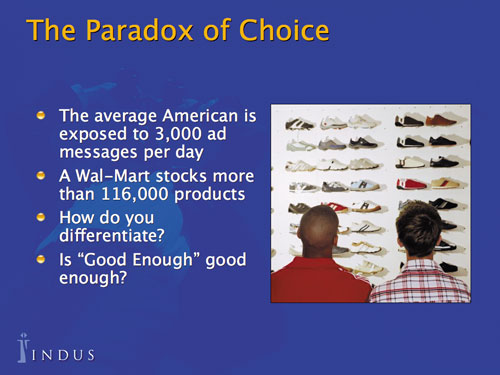
3. Paradox of Choice
The third and perhaps most influential trend that is supercharging service may appear more abstract than the other two, that of service as a differentiator. From the billboard touting a new luxury sedan to the TV commercial introducing the latest cell phone gadget to the magazine ad promoting the latest in men’s deodorant, the average American encounters at least 3,000 advertisements per day. Options reflect an American right – the freedom to choose, or so the marketplace tells us. However, psychologists disagree. Instead of control over our lives because our options are limitless, we often become overwhelmed by the chaos, resulting in what social psychologist Leon Festinger coined “cognitive dissonance.” The greatest dissonance occurs when the choices look equally attractive. According to Aberdeen’s Vigoroso, “Products by themselves are feeling the pressures of commoditization and competition, so it’s becoming difficult for manufacturers to distinguish their product from others. Feature-function isn’t enough to win the day.” Additional bells and whistles on a product won’t sell it when all the products have similar bells and whistles. What’s a business to do to avoid what Swarthmore College psychology professor Barry Schwartz called “The Paradox of Choice,” when “good enough” guides a consumer’s buying decisions? “You have to sell an experience. It’s becoming the only way to garner market share,” Vigoroso added.
It wasn’t always like this. Consider the evolution of the cell phone. Of the cell phones available about twenty years ago, there were only two options: an 11-pound Nokia or the 3-pound, four-thousand-dollar Motorola. Throughout the last twenty years, in order to be competitive, wireless companies focused on reducing the cost and size of cell phones while increasing the battery life. They’ve obviously achieved their goal. Today, according to The New Atlantis, Journal of Technology and Society, more people have cell phones than fixed telephone lines, both in the United States and internationally.
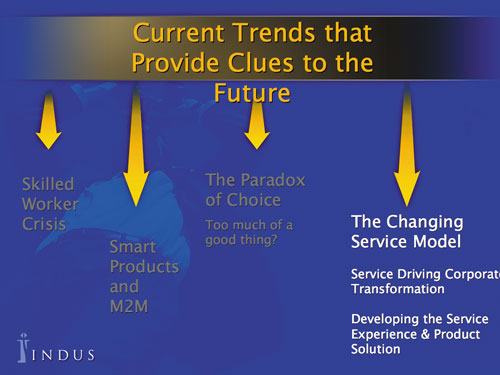
In addition, there are more than 208 million wireless subscribers in the U.S. alone. With every carrier offering the latest and greatest feature and function, how’s a carrier to stand out from his peers? The answer is in delivering the highest quality service.
Verizon seems to understand this with their “Can you hear me now?” ad campaign. They’re selling an experience – not just a product. And BMW; it’s not just the ultimate driving machine, but also the ultimate service for that machine – hence, the ultimate driving ’experience’. And on the business-to-business side, service level agreements will demand 100-percent equipment availability with severe penalties for failure to perform. With the right parts, the right person, at the right place and the right time, even the cable company’s promise that: “We’ll be there between noon and five” will no longer be acceptable.
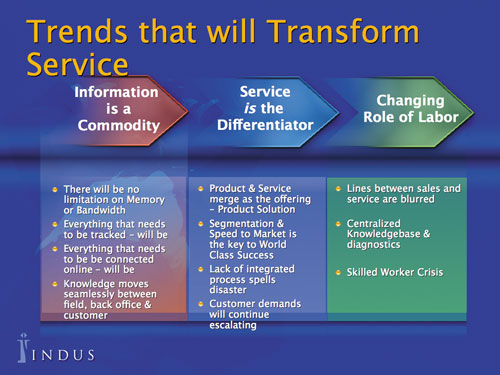
Businesses that want to ride the wave of change rather than sink under it will work on their business processes and examine the trends and influences that are changing the world, not just their specific dimension(s) of the industry. Smart businesses will invest in technology to supercharge service. And service will in turn supercharge their performance and their profit, helping to make them best-in-class.
1“The Retiring Workforce Is Creating A Knowledge Void In Government And Regulated Industries”, Forrester Research, Inc., May 2005
About the Author
Steve Roth, Vice President, Marketing Steve Roth joined Indus as vice president of marketing in November of 2000.
With responsibility for both corporate and product marketing, Steve leads the development of strategy and execution of tactics on a global basis. Since early 2003, he has also served as thought leader in Indus' Service Delivery Management (SDM) initiative, charged with researching market needs and guiding acquisition activities surrounding this crucial solution strategy.
To Indus clients, Steve brings a strong focus on delivering economic value. To our company, he brings a passion for results-oriented marketing. Roth has two decades of experience in the process industries marketplace, where he has held a variety of sales, marketing and operational leadership positions. For 10 years prior to joining Indus, Roth served as managing director of Solaronics International, a highly profitable division of Solaronics Process S.A. From the division's base in Atlanta, GA, Steve established the North American operations and managed all of the company's sales, marketing, field service and administrative resources for the Americas. In addition to this geographic responsibility, Steve was a key member of the Solaronics management team responsible for taking the company public. The company was subsequently purchased by Belgian-based Bekaert in January of 2004.
Steve has also held positions in operations, sales and marketing for IBM, Measurex-Devron (a division of Honeywell Inc.), and TechMark Corporation. He holds a Bachelor of Science degree in management information systems from the University of Rhode Island.







